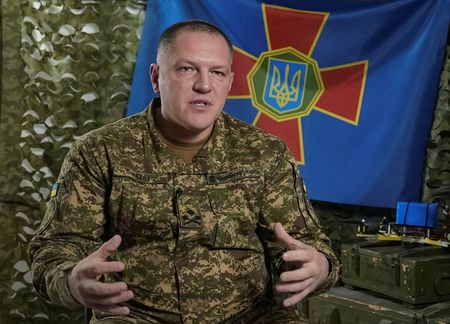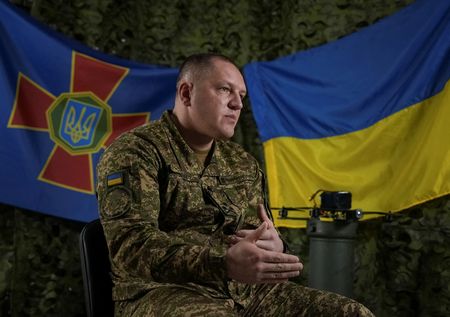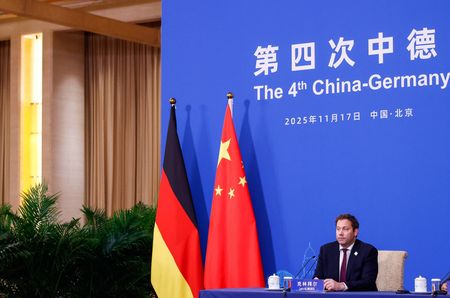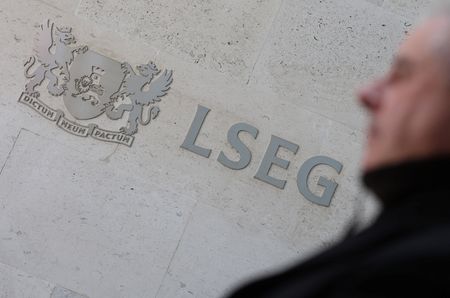By Olena Harmash
KYIV (Reuters) -As winter looms and Russian forces adapt their tactics, Ukrainian troops need to double down on technological innovation and flood the front line with more drones to halt Moscow’s territorial gains, a senior commander said.
Oleksandr Pivnenko, head of Ukraine’s National Guard, said Russia continued to have the manpower advantage after nearly four years of war in Ukraine, but Kyiv and Moscow had parity in drones in key battlefield areas.
“It is not easy for us now. I think it will be consistently difficult … because there is wet mud, it will be harder to drive,” Pivnenko told Reuters in an interview.
Late autumn and early winter are traditionally difficult for both armies because fields, tracks and roads become difficult to negotiate in wet weather. In very cold temperatures, the earth hardens, improving manoeuvrability.
“We need to stop the enemy more as they approach on foot, so that they do not infiltrate, and do not let them through,” Pivnenko said.
“If we carry out these tasks with greater density on the front line and the enemy infiltrates less deeply, it will be better for us.”
COMMANDER SEES THE NATURE OF WAR CHANGE
Since Russia launched its full-scale invasion of Ukraine in February 2022, fierce fighting has raged along more than 1,200 km (745 miles) of front lines. Russia says it now controls about 19% of Ukraine.
But the nature of combat has changed drastically, said the 39-year-old general, who fought Russian forces in the eastern city of Bakhmut before the mass deployment of drones that now hover above the front lines targeting anything that moves.
Bakhmut fell to Russian forces in mid-2023 after nearly a year of fierce fighting and artillery and missile strikes that flattened the city. Pivnenko’s units are now defending the strategic city of Pokrovsk against soldiers and drones.
To accelerate their advance in Pokrovsk, Russian troops have changed tactics and entered the city in small groups. Within weeks, they were active in several parts of the city, relying on drones to provide cover and identify and attack enemy positions.
To offset a shortage of troops that has allowed the enemy to break through defensive lines, Ukraine needs to quickly harness technological and tactical change, Pivnenko said.
One way of doing this would be to better coordinate the “layers” of drone operations so that those who operate drones closer to the contact line, for example, do not compete with or duplicate those further back.
“We need to build this in tiers,” he said. “So that one unit deals with one thing and another with others. And we do not get in each other’s way.”
YOUNGER COMMANDERS, GREATER DYNAMISM
Pivnenko was appointed in 2023 and has focused on increasing the number and variety of drones used by his units, improving and expanding training for newly mobilised soldiers and helping maintain morale among exhausted troops.
“During the war, modern war, we need to be very flexible, adaptable, and it is working. Standing still is not an option. Either act or don’t,” Pivnenko said.
The National Guard is among the first in Ukraine’s defence forces to have almost completed a move from a brigade-based structure to a corps-based one that comprises several brigades.
Pivnenko now commands two corps – Azov and Khartia – two of Ukraine’s best-known and most respected fighting forces.
He said the reforms would help strengthen Ukrainian defences thanks to better controls, command and coordination, and would promote younger commanders with combat experience.
“Young commanders are more decisive, less experienced, but more determined to take action, and to change something in the situation in general. That’s what they’re focused on, change,” he said.
(Additional reporting by Serhiy Karazy and Anna Voitenko, Editing by Mike Collett-White and Timothy Heritage)












